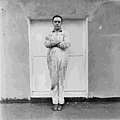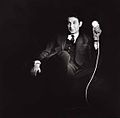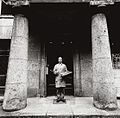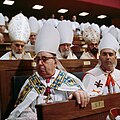Lothar Wolleh
This article needs additional citations for verification. (April 2009) |
This article includes a list of general references, but it remains largely unverified because it lacks sufficient corresponding inline citations. (April 2017) |
Lothar Wolleh | |
|---|---|
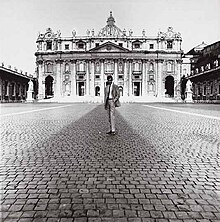 Self-portrait in front of St. Peter's Basilica, 1964 | |
| Born | January 30, 1930 Germany |
| Died | September 28, 1979 (aged 49) |
| Nationality | German |
| Occupation | Photographer |
| Known for | Commercial photographer |
Lothar Wolleh (January 20, 1930 – September 28, 1979) was a well-known German photographer.
Until the end of the sixties, Lothar Wolleh worked as a commercial photographer. He took portraits of international contemporary painters, sculptors and performance artists. Altogether, he photographed about 109 artists, including known personalities such as Georg Baselitz, Joseph Beuys, Dieter Roth, Jean Tinguely, René Magritte, Günther Uecker, Gerhard Richter, Edward Kienholz, Otto Piene, Niki de Saint Phalle, and Christo.[1]
Life[]


Lothar Wolleh was the first of four sons of the single worker Else Martha Wolleh born in Berlin-Wedding. He spent the war years in Berlin. The bombing of the Allies, especially the death of the uncle's family as well as his participation "in the last squad" in the final battle for Berlin in April and May 1945 have left deep psychological traces throughout his life. In the years from 1946 to 1947 he studied "concrete painting"[2] in the elementary school class at the Hochschule für angewandte Kunst in Berlin-Weißensee.[3]
From December 1947 to October 1949, he lived in “Boys Town” in Bad Vilbel, a camp run by the US Army for uprooted young Germans, based on the approach of Father Edward J. Flanagan. A few months after his return to Berlin in July 1950, he was arrested by the Soviet occupying forces and sentenced by a special court "OSO" (remote judgement from Moscow) to 15 years in a forced labor camp for alleged espionage and diversion under Articles 58.6 and 58.9 of the USSR. Until 1956 Wolleh was in the GULAG labor camp Vorkutlag in the USSR, where he did forced labor in a coal mine. Wolleh was able to return to Berlin in 1956, due to Konrad Adenauer's successful negotiations on the return of German prisoners of war.[4] The torture after the arrest and the hard detention and working conditions in coal mining left behind physical damage and post-traumatic disorders. At the same time, the GULAG labor camp Vorkutlag established his first contact with photography and a mythical worship of light.
After his return from prison, from 1956 to 1957 Wolleh obtained an education in the Lette-Verein, a continuation school for photography, design and fashion in Berlin.[5][6] He took part in a regular monthly recovery program of the World Council of Churches for war-disabled youth. This program made it possible for him to visit the Swedish island of Gotland in 1958, which was a motivation for his lifelong strong affinity towards Sweden, its culture, landscape and people.[7]
From 1962 until his death he lived and worked in Düsseldorf as a freelance photographer. Initially, he worked primarily in advertising and later turned to his artistic work. In 1964 he married his wife Karin. His son Oliver was born in 1965, his daughter Anouchka in 1966. In 1979 Lothar Wolleh died after an asthma attack in London, after he had portrayed Henry Moore. His grave is on Gotland.
Work[]
As a freelancer for the advertising agency TEAM, which also included Helmut Newton, Wolleh became one of the most famous and expensive fashion, advertising and portrait photographers in the Federal Republic of Germany. His clients included well-known companies such as the Deutsche Bundesbahn, Tchibo or Volkswagen. In 1965 he portrayed Chancellor Ludwig Erhard for the campaign for the general election.
In the years 1962 to 1965 Wolleh photographed the Second Vatican Council in Rome. With the help of Father Emil Schmitz SJ, Wolleh's first photo book Das Konzil, II Vatikanisches Konzil published in 1965 by the publisher Belser. In 1975 he photographed the Jubilee celebration, and published the photographic folios Apostolorum Limina (1975). This work, with its blurring, represents a radical evolution of Wolleh´s color photography, as suggested by the first book Das Konzil, II Vatikanisches Konzil.
In 1969, Wolleh traveled for several months through the Soviet Union. The photographs taken on this journey found their way into the 1970 illustrated book USSR - The Soviet State and its People, which he published together with Heinrich Böll and with Belser publisher.
In the late 1960s, at the request of his friend the German painter Günther Uecker, Wolleh began to systematically portray more than one hundred international well known painters, sculptors, and Actionists.[8][9] From the 1970s Wolleh hardly worked as a commercial photographer and devoted himself almost exclusively to his series of artist portraits, in which he first photographed the well-known artists of the Düsseldorf scene, including Heinz Mack, Otto Piene, Joseph Beuys and Gerhard Richter. Soon, however, his project expanded beyond the borders of the Rhineland to the whole of Europe, focusing on the Zero (art) group or the Nouveau Réalisme with its members like Niki de Saint Phalle and Jean Tinguely.
Out of this project several comprehensive photobook-projects evolved:
- 1970- UdSSR (USSR)
- 1972- Art Scene Düsseldorf [10]
- 1972- Apostolorum Limina
- 1973- Das Unterwasserbuch (The Underwater Book, together with Joseph Beuys)
Several book and art portfolio projects remained unfinished, so a volume to Lucio Fontana, , The illustrated book "Men of Management", in which company founders and managers of the leading German companies were portrayed not to be released because of feared attacks by the Red Army faction. Further projects were the underwater book, which Beuys and Wolleh had planned together and created the 51 format-filling pictures for the book. The photographs were taken during the construction of the Beuys exhibition at the Moderna Museet in Stockholm in 1971.[11]
Between 1977 and 1979 there were several stays in Poland. in the Wolleh until his death at the unfinished photo volumes The black Madonna of Czestochowa and Wawel Castle worked. During this time, numerous portraits of the Polish avant-garde emerged.[1]
Wolleh's photograph of René Magritte and his wife is said to have inspired Paul Simon to compose the ballad "Rene And Georgette Magritte With Their Dog After The War".
In his work, Lothar Wolleh pursued idiosyncratic creative principles that give his portraits an unmistakable signature. His works are precisely designed and staged through a clear, often strictly symmetrical image structure. The portrayed persons are usually placed as a whole figure on the vertical central axis in the upper half of the picture. Often the camera is on the ground or near the ground, so that it occupies almost the entire lower half of the picture, receives a base function and a clear horizon line divides the image area. Another characteristic is the black and white photography, in the context of a basically square format.[12] In total, Lothar Wolleh portrayed 109 artists.[13]
In 2007, the comprehensive retrospective Lothar Wolleh – Eine Wiederentdeckung: Fotografien 1959 bis 1979 (Lothar Wolleh - A Rediscovery: Photographs 1959 to 1979) was shown in Germany at Kunsthalle Bremen, Stadtmuseum Hofheim, Kunstmuseum Ahlen and the Deutschherrenhaus Koblenz.[14]
Selected exhibitions[]
- 1962: Otto Steinert und Schüler. Fotografische Ausstellung, Gruppenausstellung in der Göppinger Galerie, Frankfurt/Main
- 1964: Farbige Fotografie. Bilder aus dem Vatikan, Einzelausstellung: Schatzkammer des Essener Münsters. Die Ausstellung wurde vom Essener Bischof Hengsbach (am 21. März 1964) eröffnet
- 1965: Zyklus von Farbfotos zum römischen Konzil, Einzelausstellung in der Galerie Valentin, Stuttgart
- 1980: Lothar Wolleh: Künstlerbildnisse. Kunstobjekte, Photographien, Einzelausstellung der Künstlerporträts in der Städtischen Kunsthalle Düsseldorf
- 1986: Lothar Wolleh - Das Foto als Kunststück" Einzelausstellung der
- 1995: "Lothar Wolleh 1930-1979: Künstlerbildnisse - Kunstobjekte, Photographien“
- 2005–2007: Lothar Wolleh. Eine Wiederentdeckung: Fotografien 1959 bis 1979, Einzelausstellung: Kunsthalle Bremen, , Kunst-Museum Ahlen, Stadtmuseum Hofheim am Taunus
- 2006: Joseph Beuys in Aktion. Heilkräfte der Kunst – Gruppenausstellung: museum kunst palast, Düsseldorf
- 2008: Fotos schreiben Kunstgeschichte – Gruppenausstellung: museum kunst palast, Düsseldorf
- 2008: Staatliche Museen zu Berlin, Kunstbibliothek, Unsterblich! Das Foto des Künstlers
- 2008: Lothar Wolleh: Künstlerportraits Galerie f5,6, München
- 2009: „Lothar Wolleh: Portraits d'artistes“ Goethe-Institut Paris
- 2012: "Lothar Wolleh: Joseph Beuys im Moderna Museet, Stockholm, Januar 1971", Ausstellung im Hamburger Bahnhof Museum für Gegenwart, Berlin
- 2012: “Das Kozil - Fotografien von Lothar Wolleh, Berlin” Bonifatiushaus Fulda
- 2013: “Lothar Wolleh (1930 - 1979) Das Zweite Vatikanische Konzil im Bild Fotografien” Franz Hitze Haus, Münster
- 2014: Lothar Wolleh Künstlerportraits der sechziger und siebziger Jahre, Kunstmuseum Magdeburg
- 2015: Lothar Wolleh – Die ZERO–Künstler, Galerie Pavlov’s Dog, Berlin
- 2015: Lothar Wolleh - Vaticanum II, Galerie f5,6, München
- 2017: Lothar Wolleh - Portraits international bekannter Künstler, Galerie Ruth Leuchter, Düsseldorf
Public collections[]
- Kunsthalle Bremen
- Museum Folkwang, Essen
- Museum Kunst Palast, Düsseldorf
- Tate Gallery / National Gallery of Scotland
- Muzeum Sztuki in Łódź, Łódź
Gallery[]

Armand Pierre Fernandez
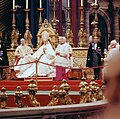
Paul VI
Publications[]
- 1965: The Council: The Second Vatican Council; Chr. Belser Verlag
- 1970: UdSSR. Der Sowjetstaat und seine Menschen. (USSR: The Soviet State and its people); Chr. Belser Verlag
- 1971: Günther Uecker / Lothar Wolleh: Nagelbuch; Verlag Galerie Der Spiegel, Köln
- 1972: Lothar Wolleh: Art Scene Düsseldorf 1; Chr. Belser Verlag
- 1973: Das Unterwasserbuch (The Underwater Book, together with Joseph Beuys.)
- 1975: Lothar Wolleh: Apostolorum Limina; Arcade Verlag, Arcade Verlag
- 1978: Günther Uecker: Ludwig van Beethovens Leonore. Idee einer Oper; Besser Verlag
- 1981: Lothar Wolleh (Photo), Günther Uecker, Guido de Werd (Text): Bühnenskulpturen für Lohengrin, Städtisches Museum Haus Koekkoek, Kleve
Notes[]
- ^ Kunstverein für die Rheinlande und Westfalen Düsseldorf (ed.), 1980, p. 8.
- ^ Herzogenrath (ed.), 2005
- ^ Herzogenrath (ed.), 2005
- ^ Herzogenrath (ed.), 2005
- ^ Herzogenrath (ed.), 2005
- ^ Kittelmann(ed.), 2012
- ^ Herzogenrath (ed.), 2005
- ^ Kunstverein für die Rheinlande und Westfalen Düsseldorf (ed.), 1980, p. 15.
- ^ Welti, 1980, p. 38.
- ^ Patricia G. Berman, Art Scene Düsseldorf: The Performative Print, in: Reinhold Heller, Anja Chávez, Two and One, Printmaking in Germany 1945-1990, Davis Museum and Cultural Center, Wellesley College, Wellesley, Mass., 2003
- ^ Kittelmann(ed.), 2012
- ^ Kittelmann(ed.), 2012
- ^ Kunstverein für die Rheinlande und Westfalen Düsseldorf (ed.), 1980.
- ^ Herzogenrath (ed.), 2005
References[]
- Kunstverein für die Rheinlande und Westfalen Düsseldorf (ed.) (1980). Lothar Wolleh: Künstlerbildnisse – Kunstobjekte. Photographien. Germany: Kunstverein für die Rheinlande und Westfalen Düsseldorf.CS1 maint: extra text: authors list (link)
- Welti, Alfred (1980). Das Foto als Kunststück. Hamburg: in: Art – Das Kunstmagazin, no. 8 Gruner & Jahr. pp. 38–45.
- Herzogenrath, Wulf (2005). Lothar Wolleh – Eine Wiederentdeckung: Fotografien 1959 bis 1979. Bremen: Hauschild. ISBN 3-89757-304-0.
- Lowis, Kristina (2008). Unsterblich! Das Foto des Künstlers. Berlin: Staatliche Museen zu Berlin. ISBN 978-3-88609-656-5.
- Kittelmann, Udo (2012). Lothar Wolleh – Lothar Wolleh. Joseph Beuys im Moderna Museet, Stockholm, Januar 1971. Köln: Buchhandlung Walther König. ISBN 978-3-86335-263-9.
External links[]
![]() Media related to Lothar Wolleh at Wikimedia Commons
Media related to Lothar Wolleh at Wikimedia Commons
- 1930 births
- 1979 deaths
- 20th-century German photographers
- Photographers from Berlin
- Deaths from asthma




